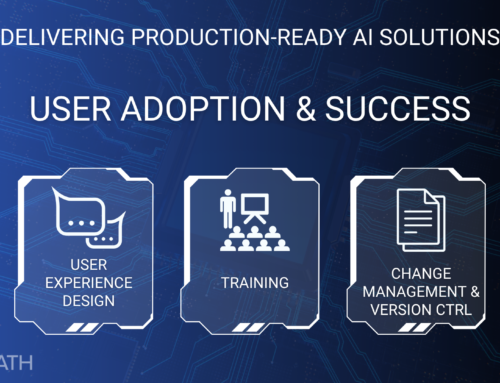Deploying a machine learning model is just the beginning, especially for enterprises.
To ensure continued success, organizations must focus on monitoring the entire end-to-end machine learning solution. From data pipelines to model performance and application integration, every component plays a crucial role in delivering accurate, reliable, and actionable insights. Proper monitoring not only helps maintain high model performance but also ensures system scalability, security, compliance, and a seamless user experience.
In this article, we explore some of the considerations required in a comprehensive monitoring solution that is essential for enterprises to maximize the value of their machine learning investments and mitigate potential risks.
Key Monitoring Considerations
![]()
1. Business Impact
- Alignment with Business KPIs: Ensure that the model's outputs are aligned with key business metrics like revenue, customer satisfaction, or operational efficiency. Regularly assess whether the model is positively influencing these KPIs.
- Cost-Benefit Analysis: Monitor the cost of deploying and maintaining the model versus the business value it generates. This includes cloud infrastructure costs, data storage, and personnel.
- Impact on Decision-Making: Track how the model's predictions influence business decisions and outcomes. Evaluate if the model improves decision-making or introduces risks.
- Alerting on Anomalous Business Metrics: Set up alerts for when the model's output negatively impacts business metrics, such as a drop in sales or increased customer churn.
![]()
2. Security
- Data Privacy: Ensure that data used for training and inference complies with privacy regulations (e.g., GDPR, CCPA). Monitor data access logs to prevent unauthorized access.
- Access Control: Implement role-based access controls (RBAC) to limit who can access the model, data, and predictions. Monitor access patterns for signs of unauthorized use.
- Model Integrity: Protect against model theft or tampering. Monitor for unusual access or modification attempts on the model.
- Adversarial Attacks: Watch for signs of adversarial attacks where inputs are crafted to fool the model. Implement anomaly detection to catch abnormal input patterns.
![]()
3. Infrastructure
- Resource Utilization: Monitor CPU, GPU, memory, and network usage to ensure the infrastructure is not over or underutilized. This helps optimize cost and maintain performance.
- Scalability: Ensure the infrastructure can scale up or down based on the workload. Monitor auto-scaling events and the system's ability to handle peak loads.
- Fault Tolerance: Monitor the infrastructure for failures and implement redundancy to prevent single points of failure. Track uptime and reliability metrics.
- Service Health: Use health checks to monitor the status of services involved in the ML pipeline (e.g., model servers, databases, message queues).
![]()
4. CI/CD Pipeline
- Automated Testing: Ensure that changes to data, model code, or infrastructure trigger automated tests, including unit, integration, and performance tests. Monitor test outcomes to catch issues early.
- Model Versioning: Monitor the CI/CD pipeline for the deployment of new model versions. Track the performance of each version to facilitate rollbacks if needed.
- Deployment Rollbacks: Monitor the pipeline's ability to roll back to a previous version if the new deployment negatively impacts performance.
- Pipeline Health: Track the success and duration of pipeline runs. Identify bottlenecks or failures in the CI/CD process.
![]()
5. Application Performance
- End-to-End Latency: Monitor the entire data flow, from data ingestion to model serving and user interface, to measure the total response time. This includes network latency, data preprocessing time, model inference time, and the time taken to display results to the end user. Set up alerts for any latency spikes that could affect user experience or downstream processes.
- System Throughput: Track the number of transactions or predictions the system can process per second, encompassing data pipelines, the model serving layer, and the user-facing application. Ensure that the entire system can handle peak loads without performance degradation.
- Error Rates and Failures: Monitor the rate of errors across all components, including data processing errors, model serving errors, API failures, and UI errors. Implement comprehensive logging and alerting mechanisms to identify and troubleshoot issues quickly across the entire solution.
- Resource Utilization Across Services: Monitor the CPU, memory, storage, and network usage of all components in the solution, including data storage systems, ETL processes, model serving infrastructure, and the application backend. Ensure optimal resource allocation to prevent bottlenecks and reduce costs.
- Scalability and Load Balancing: Ensure that all parts of the enterprise solution, including data pipelines, model servers, and application servers, can scale in response to increasing load. Monitor auto-scaling events and the effectiveness of load balancers to maintain consistent performance under varying workloads.
- Inter-Service Communication: Monitor the performance of inter-service communications, including API calls, message queues, and data transfers. Track latency, error rates, and throughput to ensure seamless interactions between different components of the system.
- User Experience Monitoring: Collect and analyze user feedback, application performance metrics (e.g., page load times, responsiveness), and user behavior analytics. Ensure that the end-to-end solution meets the desired performance standards, providing a smooth user experience.
- Availability and Uptime: Monitor the availability of all critical components, such as data sources, model servers, databases, and APIs. Implement health checks and failover mechanisms to ensure high availability and minimal downtime across the entire enterprise solution.
![]()
6. Data Pipeline
- Data Quality: Monitor incoming data for completeness, accuracy, and consistency. Set up alerts for anomalies such as missing values, outliers, or changes in data distribution.
- Pipeline Health: Track the status of data ingestion, transformation, and loading processes. Monitor for pipeline failures or delays that could impact model predictions.
- Data Drift: Continuously monitor input data for drift, where the statistical properties of the input data change over time, potentially degrading model performance.
- Latency and Throughput: Ensure the data pipeline can handle the required data volume within the necessary time frame.
![]()
7. Model Training
- Training Performance: Monitor metrics like training time, resource utilization (CPU/GPU/memory), and convergence of the training process. Detect issues like vanishing gradients or overfitting.
- Data Quality for Training: Ensure the training data is of high quality and consistent with the production data. Monitor for changes in data quality that could affect future training.
- Hyperparameter Tuning: Monitor the results of hyperparameter tuning experiments to identify the best-performing model configurations.
- Reproducibility: Track the training environment, code, data, and parameters to ensure that training runs are reproducible.
![]()
8. Model Performance
- Model Accuracy: Continuously evaluate the model against a holdout dataset or in a live setting. Monitor metrics like accuracy, precision, recall, and F1 score to ensure the model performs as expected.
- Model Drift: Monitor for changes in the model's performance over time due to data or concept drift. Set up retraining triggers when performance falls below a predefined threshold.
- Prediction Confidence: Monitor the confidence scores of predictions to detect potential degradation in model certainty.
- Business Metrics Correlation: Track how changes in model performance metrics correlate with business outcomes. This helps to assess if the model's performance aligns with business goals.
![]()
9. Bias
- Bias Detection: Continuously monitor model outputs for potential biases against specific groups (e.g., based on race, gender, age). Implement fairness metrics such as demographic parity, equalized odds, or disparate impact to quantify bias.
- Data Representativeness: Ensure that training and production data are representative of the real-world population or use case. Regularly monitor the input data to identify imbalances or underrepresented groups that could lead to biased predictions.
- Impact Analysis: Evaluate the impact of the model's predictions on different user segments. Monitor for unintended negative consequences on certain groups and assess how these outcomes align with ethical and business guidelines.
- Bias Mitigation: Implement and monitor bias mitigation strategies such as re-sampling, re-weighting, or fairness constraints. Track the effectiveness of these interventions to ensure they reduce bias without significantly harming model performance.
- Feedback Loop: Collect feedback from stakeholders, including affected users, to identify biases that automated monitoring may miss. Incorporate this feedback into ongoing model development and monitoring practices.
Conclusion
By addressing these considerations (and others based on the business requirements), enterprises can maintain robust, secure, and high-performing ML solutions that align with business objectives. Failing to monitor every aspect of a machine learning solution in an enterprise environment can lead to significant risks, including model drift, data quality issues, security vulnerabilities, and compliance breaches. This lack of oversight can result in inaccurate predictions, biased outcomes, operational disruptions, and costly resource usage. Additionally, it can lead to a loss of accountability, transparency, and competitive advantage, potentially causing reputational harm, legal challenges, and financial losses. Continuous monitoring is crucial to ensure the reliability, efficiency, and ethical operation of ML systems.





